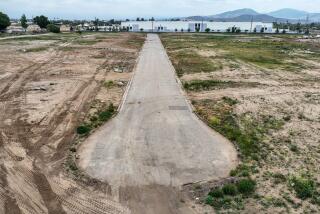1993 Report Withheld Information on El Toro : Conversion: Portion favoring base as a commercial airport was not released in public version of study.
- Share via
As political tension mounted last summer between factions that either favored or opposed a commercial airport at the El Toro Marine Corps Air Station, a regional planning agency suppressed parts of an FAA-funded study showing that El Toro had the greatest potential to succeed of three area military bases coming available for conversion.
“El Toro could be a very viable commercial airport in terms of serving demand, since it would attract about 4 million passengers per year, which is more than Burbank Airport currently serves,” the study found after an extensive survey of airline passengers and booking agents, and weighing factors ranging from proximity to travelers’ homes to potential parking fees.
“These results are not surprising since it has long been known that Orange County has the largest problem in the region in terms of having inadequate airport capacity to serve its own demand”--a situation that obliges Orange County travelers to take flights from airports in Los Angeles and San Bernardino counties.
The study also found that “John Wayne (Airport) would be little affected,” even if 40% of the flights from a new El Toro airport were so-called “long-haul” flights to cities more than two hours distance in a commercial jet.
While the existence of the study was an open secret last spring and some of its conclusions were generally known to Orange County officials involved in the debate over El Toro, the Southern California Assn. of Governments (SCAG) withheld the specific findings about the base from a version of its April, 1993, report released to the public.
But the El Toro results were included in another version of the report--also dated April, 1993, and identical in every other respect--submitted to officials at John Wayne Airport. The report was recently obtained by The Times in response to a request under the California Public Records Act.
Mark Pisano, the executive director of SCAG, acknowledged Friday that two versions of the base study indeed existed. He said the one that included El Toro had been supplied to the technical staffs of other local agencies months ago as a “work in progress” and he does not think the agency was obligated to share it with the public. He said an expanded version of the study is expected to be released in February or March.
Since 1974, the California Supreme Court has held that “selective disclosure” of information by a public agency is unlawful, and that every citizen has the right to government information when an agency releases it to another party.
“If we cannot work together (with other agencies) as a technical team, I don’t think that’s a good process,” Pisano said. He said he did not think that SCAG had actually run afoul of the selective disclosure ruling, because the report had not been transmitted in a manner he deems official.
Gaddi H. Vasquez, the current chairman of SCAG and an Orange County supervisor whose district borders the base, said Friday he did not think that SCAG officials had been playing politics in their handling of information about the Marine base’s suitability as a commercial airport.
“I have been very deliberate (as the chairman of SCAG) to ensure that the process runs its course in the way that SCAG would do any other analysis,” said Vasquez, who has been in the thick of the debate over the base’s future. Vasquez said he has never seen the El Toro report.
In August, however, Mike Armstrong, the SCAG project manager overseeing the study, told a gathering of airport officials that the El Toro results were in, but were being held up because the issue had become a political “hot potato.” Added Armstrong: “What I can tell you right now is that El Toro does work pretty well” as a commercial airport.
Armstrong said SCAG officials were “waiting for the political dust to settle” before releasing the study’s results to the public.
The study was undertaken to help local governments decide whether closed or downsized military bases could be converted into commercial airports. A key objective was to see if the potential new airport sites were “close enough to urban population centers to serve the traveling public. . . . This is extremely important since many military bases are simply located too far away from population centers to serve them commercially.”
When the first report was publicly released last April without findings on El Toro, SCAG officials said that part of the study had not been completed. The report that was released addressed the impact on existing regional airports, such as Orange County’s John Wayne Airport, only in light of the possible closures or downsizing of Norton Air Force Base in San Bernardino County and March Air Force Base in Riverside County.
The bound copy of the report contained in John Wayne Airport files is virtually identical to the one publicly released, except that it includes the El Toro information along with three full-page charts that show passenger demand scenarios if El Toro were turned into a commercial aviation facility.
The report “really did not show anything that was not known before,” executive director Pisano said, adding that he, too, had never laid eyes it.
Rumors of the report’s existence began circulating in political circles last spring, just as the battle was beginning over who would decide El Toro’s future.
It was then that the Orange County Board of Supervisors claimed sole authority to determine the future of the 4,700-acre base, only to have that claim challenged by South County cities that oppose its conversion to a commercial airport, fearing that an airport would bring more noise and congestion to their communities.
Had the report been released last summer, it probably would have placed county officials in the middle of a political firestorm, with South County city officials questioning the county’s objectivity on the airport issue because of the county’s influence at SCAG, and North County cities trumpeting the results in their fight for an airport.
But officials on both sides of the airport issue said Friday that if SCAG delayed releasing the report to avoid political flak, then it was mistaken.
Garden Grove Councilman Mark Leyes, who has been organizing the pro-airport movement in North County, said he did not think that release of the report last summer would have made any difference, and that the uproars in North and South County cities probably would have canceled one another out.
“What is troubling is that withholding that information about El Toro might not only skew the decisions on El Toro, but it might impact the decisions on Norton or even some of the other existing airports, and that would be unfortunate,” Leyes said. “I would hope that that kind of information, prepared at public expense, would not be withheld from the public.”
Marcia Rudolph, the mayor of Lake Forest, said SCAG has long favored the development of a commercial airport at El Toro, so the study’s findings come as no surprise. “The thing I find amusing is that they would play games with when they were going to release the report, as though it were going to be some major thunderbolt of lightning or a surprise to us.”
Vasquez also played down the shock value and the significance of the report, saying “whatever analysis is done in the end is not going to drive the (decision-making) process. There are many, many other considerations that need to be taken into account.”
The report concluded:
* If Norton and El Toro were added to the airport system, with 80% of El Toro’s service made up of short-haul flights and the balance consisting of long-haul service, it would attract about 4 million passengers a year--1 million below the number of passengers who would use John Wayne. The airport would draw passengers from all of the airports, with most of the clients coming from Los Angeles, John Wayne and Ontario airports.
* If El Toro’s short-haul flights were reduced to 60%, with 40% consisting of medium- and long-haul service, the number of annual passengers would increase to 5 million, almost equaling John Wayne. El Toro would become the third-busiest airport of the seven included in this scenario.
* If March, Norton and El Toro were added to the airport system, with El Toro offering mostly short-haul service, El Toro would have about 1 million fewer passengers than John Wayne, but would draw more business than Burbank, Long Beach, Norton and March.
The two airports with the fewest passengers, Norton and March, would be competing against each other, with March drawing travelers from Norton, the study concluded.
Since the summer, SCAG analysts have expanded their study to update the current passenger demand figures and to forecast what the needs of air passengers will be in the year 2010.
In addition to the El Toro, March and Norton bases, the new report expected in February or March also will consider possible civilian use of the former George Air Force Base in San Bernardino County, and joint military and civilian operations at Point Mugu Naval Air Station in Ventura County.
More to Read
Sign up for Essential California
The most important California stories and recommendations in your inbox every morning.
You may occasionally receive promotional content from the Los Angeles Times.










